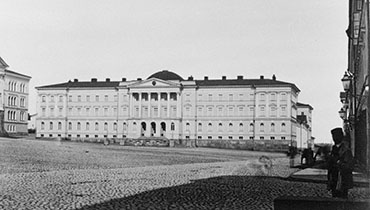History

Finland obtained its own central administration in 1809. Rules of procedure were issued to the Governing Council in August 1809, which started operating in October of the same year. The Governing Council (from 1816 the Imperial Finnish Senate) consisted of two divisions: an Economic Division, which was in charge of civil administration and economic affairs of the country, and a Judicial Division, which functioned in the capacity of court of highest instance. Soon after independence, towards the end of 1918, the Economic Division of the Senate became the Government, the administrative departments were converted into ministries and the Judicial Division of the Senate served as the Supreme Court.
The Economic Division of the Senate was divided into five administrative departments: chancery, treasury, financial affairs, military affairs and ecclesiastical affairs department. Three of these were responsible for the management of financial affairs. The department for financial affairs formulated the Budget and took decisions on budget expenditure within the framework of the Budget. It was also in charge of affairs for trade and industry until they were delegated to the newly founded department for Trade and Industry Department in 1888. The Treasury Department was responsible for overall supervision of tax levies and for auditing the state accounts. The Treasury Department was discontinued in November 1917 and all its functions were transferred to The Financial Affairs Department. The Military Affairs Department handled matters related to state finances too, being in charge of the financial affairs of soldiers who had served in the army during the time it was financed based on an allotment system. The Military Affairs Department was responsible for levying certain taxes, for bookkeeping and for assigning termination wages and pensions. The department was discontinued in 1841, when all its functions were transferred to the department for Financial Affairs Department.
In the Diet of Porvoo in 1809, the Emperor of Russia and Grand Duke of Finland Alexander I solemnly declared that all taxes levied in Finland would be used solely to meet the nation’s own needs. As an autonomous Grand Duchy, Finland’s position made it possible to build its own government structures and pursue its own policies. Autonomous economic structures paved the way for political independence.
The Budget took on a new form in 1841. Revenue was classified into headings and expenditure into main titles. The Budget was published in the Statute Book of Finland in 1862.
In 1899 a decree was issued on the reorganisation of the Treasury Cash and Accounts Section, which included provisions on the principle of gross budgeting and working budget appropriations. The decree separated State revenue and expenditure into an ordinary and a supplementary budget.
The Cabinet Finance Committee was set up in 1917. Advance fiscal supervision, carried out by the Government, was gradually delegated to the Committee.
The Senate became the Government in 1918, the boards became ministries, senators became ministers and the financial affairs departement became the Ministry of Finance.
A three-volume series of books has been published on the history of the Ministry of Finance in Finnish. Volumes 1–2 were published in 2009 and volume 3 in 2010 (Edita Publishing).
See also
Finnish Governments and Ministers since 1917
Government Programmes since 1917
Picture: the former House of the Senate, currently the Government Palace. Source: Helsinki Art Museum, finna.fi
